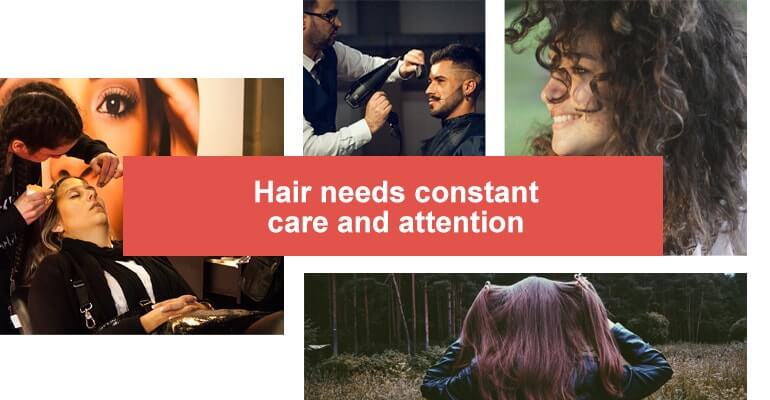What do we know about hair? How does it grows and why does it fall out? How often does hair need to be washed and combed? Is hair supposed to fall out, and how much is considered the “norm”? The majority of people don’t know anything about hair at all. We do what we are supposed to do, the routine that we learned from our parents, and sometimes we panic if our hair doesn’t cooperate with styling, or if we find it on the pillow. We gathered the top 22 of the most frequently asked questions and answers about hair.

- Keratin is the name of the protein our hair consists of.
- Normal (natural) hair loss is considered to be between 50 to 100 hairs per day.
- The most common reason for hair loss is stress, but we often need a doctor to detect it.
- Hormones can also start the balding process. Sometimes it’s enough to restore the hormonal balance. It can be caused by hypo– or hyperactivity of the thyroid, androgens, or an estrogen imbalance.
- For the first 3 months after pregnancy, hair might be influenced by hormonal malfunction. Don’t panic. Hair usually comes back to normal with the right diet. Sometimes hair needs extra support, in this case, GRIVAMAX LASER CAP 80 can help.
- Anticoagulants, gout medications, contraceptives, antidepressants, and steroids are the drugs which can cause baldness. Most likely, hair gets restored after the therapy course is over. If it didn’t happen during three to six months, we recommend seeing a doctor.
- Another reason for hair loss can be a fungal infection. Usually, after a treatment course with antifungal medications, hair will become restored.
- Tightly braided tails and braids, and frequent use of curlers and flat irons can cause hair to fall out. The same effect on hair can have an excessive use of styling products – hair dyes, sprays. Let your hair breath (hair can dry on its own, and you can use your own hands for styling sometimes).
- There is a special type of balding (alopecia), which is caused by immune system disorders. The symptom is the appearance of small bald patches that can grow back during the year, but there is no guarantee that the problem is gone for good. New bald spots can show up at any time. After consulting with the doctor, you can use GRIVAMAX LASER CAP 272 PRO for treating and preventing the disease. More information about laser therapy and a person who invented it you can find here: https://www.grivamax.com/who-invented-the-laser/.

- Imbalanced diet has a big influence on our body, including hair growth. For example, diseases like anorexia and bulimia have a strong impact on hair condition, due to the insufficiency of basic hair components – proteins, vitamins, and minerals. Hair loss can be one of the side effects of converting to vegetarianism and changing the diet.
- Men’s (androgen) alopecia is usually caused by hormonal imbalance and genetics.
- While you were reading this article, 93% of your hair has grown and 7% is at the stage of dying out.
- Normally, 130,000 hairs are growing on the head. This number depends on the hair type and color.
- Even 1 inch of your hair can tell a lot about you: where have you lived, your diet, and whether you have experienced stresses.
- Wavy (curly) hair curls because of the specific structure and location of the follicle.
- All hair (fuzz, stubble, long) has the same structure.
- What we see on the head and call hair is really just one part: the stem. The root is located in the skin.
- Don’t comb wet hair. It’s better to style slightly dried or dry hair.
- Don’t ignore the allergy test if you are planning to dye your hair. You can test a small area of your skin on the back.
- If you notice that you have less hair than normal, or it has changed its structure – don’t waste your time on self-treatment. Contact a specialist.
Following these simple rules you will make your life easier. If you already have a problem and you are losing hair severely – don’t panic. With the right choice of baldness treatment, in most cases, your hair will be restored.
 906
906














